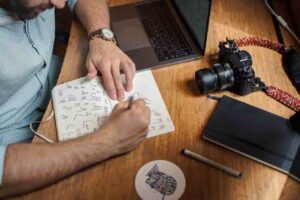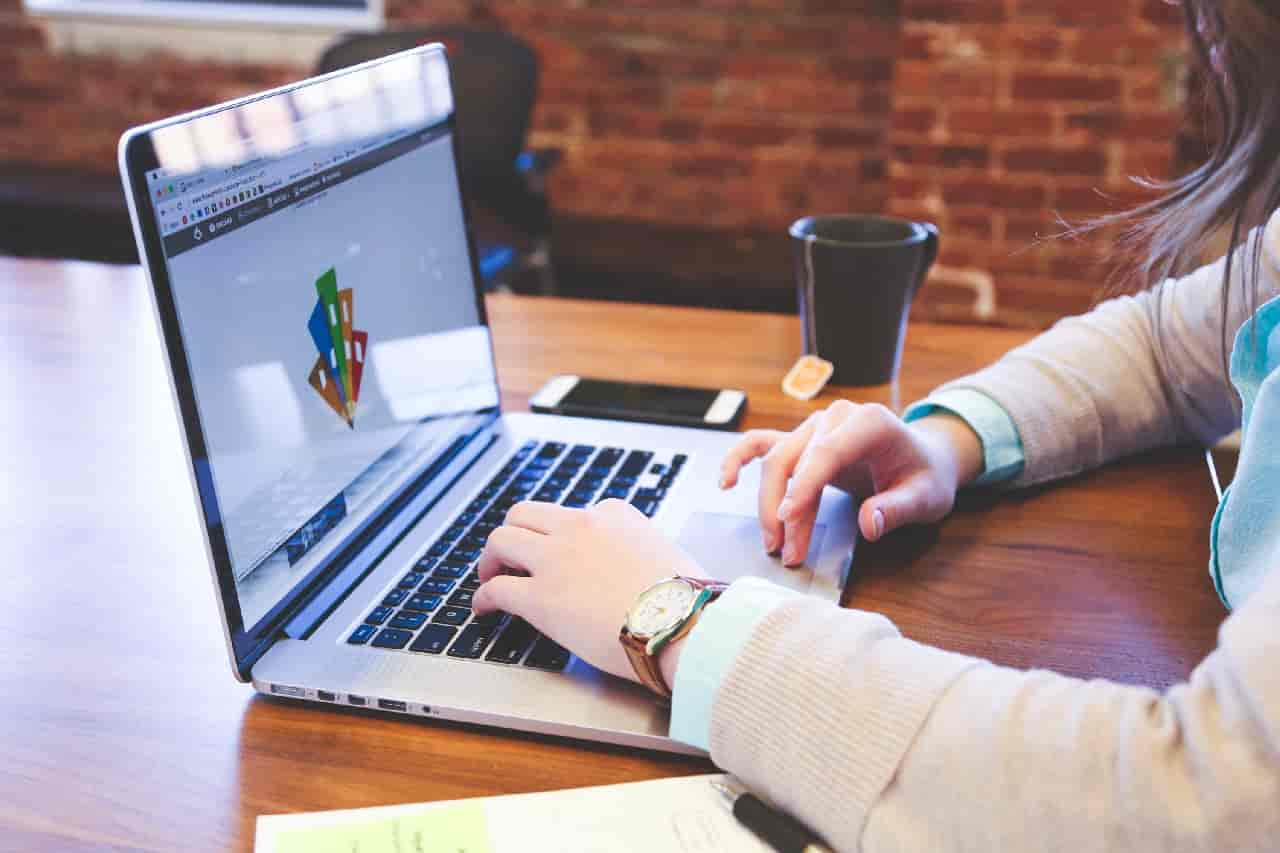If you’re a self-motivated, business-savvy, and ambitious individual with a passion for design, you can consider becoming a freelance logo designer. Freelancing is flexible and a great way to grab opportunities if you’ve got the right skills and attitude. Now, how do you get started on your career as a freelance logo designer?
Here are essential steps to take to become a freelance logo designer:
- Acquire logo design skills and knowledge.
- Create your brand.
- Build a portfolio.
- Attract potential clients online and offline.
- Over-deliver on your projects.
- Establish, nurture, and utilize your network.
- Diversify your work and clients.
- Grow a referral network to increase productivity.
Logo design is a branch of graphic design that involves creating brand logos. This article will explain how to become a freelance logo designer. Below you can learn what it takes before embarking on this career path.
1. Acquire Logo Design Skills and Knowledge
Logo design is a lucrative venture that involves applying graphic design principles. Before becoming a freelance logo designer, you must acquire adequate skills and knowledge of this profession. It’s not just about creating impressive designs but portraying what a company or brand represents in a logo.
Logo design requires a combination of:
- Creativity
- Planning
- Expertise in the principles of graphic design
Therefore, if you’re a newbie in this field, consider enrolling in a graphic design course.
You can join a structured academic course or take online classes on popular platforms such as:
- Udemy: This is a global online platform with over 183,000 courses and more than 65,000 instructors. You can either get a free course or a paid course with a 100% free coupon on this website.
- Skillshare: This is an American-based learning platform where learners get educational videos through subscription. Though not accredited, Skillshare is one of the best sites to acquire new skills.
- Allison Online: This is a global platform for free online classes. The site offers basic education and skills training in IT, sales and marketing, business, and health, just to mention a few.
- Envato Tuts+ Design & Illustration Courses: It offers tutorials and digital courses, including design, web development, illustration, photography, video, and music.
Apart from mastering the fundamentals of graphic and logo design, familiarize yourself with graphic design tools.
Adobe Creative Suite is the most common and essential graphic design tool. Others include Adobe InDesign, Photoshop, and Illustrator.
Other tools include appointment schedulers for freelancers to collaborate with clients.
While mastering how to use graphic design software, it’s crucial to have and learn how to utilize high-powered machines. Therefore, you’ll require a good computer or laptop to execute your design projects.
Some of the best PCs for graphic design include the following:
- Apple iMac: It has a 27-inch screen with a 2880 by 5120 retina (5K) display, which offers great design clarity. It also features ultra-fast SSD storage.
- Acer Aspire C24 desktop: This desktop features a 10th generation Intel Core i3-1005G1 Processor, 8GB DDR4 Memory, and 512GB NVMe Memory. So you can store lots of your graphic designs.
- Microsoft Surface Studio 2: It has a 28-inch screen with 1.5 million pixels for the best display ideal for graphic design. It also features a powerful processor (Intel Core i7-7820HQ) and a zero-gravity hinge.
While some of the best laptops are the following:
- MacBook Pro: This laptop entails the Apple M1 chip for enhanced speed and performance. Also, it has a 20 hour battery life and 11 times faster machine learning.
- Dell Precision 3540: It has a Windows 10 Pro OS and a narrow-edge display to easily view CAD applications and spreadsheets.
2. Create Your Brand
Freelancing is similar to venturing into a business as you get to be a boss, determine your schedule, and what type of work to do.

So, after mastering your expertise in logo design, creating a brand should be the next step. Brand identity is important. However, research thoroughly to acquaint yourself with business dynamics and laws that your brand will be subject to. Brand development is an ongoing process, and as a result, you must be proactive.
Some of the things to do to create your brand include:
You also have to familiarize yourself with the vital aspects of running a business. Therefore, have the basic knowledge of:
- Bookkeeping
- Managing customers
- Finances
These skills are available on online platforms, including Udemy, Skillshare, LinkedIn, and Coursera. While some require subscription and pre-paid fees, others offer free courses. Moreover, you’ll earn a digital certificate that will boost your authority and credibility among potential clients.
Moreover, set achievable goals for your business and determine the best way to achieve them.
Creating a brand will require a unique name to represent what you do (it could be your name or a business name). However, you first have to identify what kind of projects or clients you’d want to work with. Finally, come up with an appealing logo that will stand out from the rest.
Branding also entails building and maintaining an online presence to attract potential clients to your business. So, you’ll need to create a professional and eye-catching website for your business. Your site should be credible and authoritative, so you should incorporate appealing content (including your successful projects) and contact information.
3. Build a Portfolio
As a logo designer, a viable portfolio is one of the effective ways to attract clients. Many companies hire logo designers, and you just need to convey your creative ideas for a company logo.
Now, how do you build a portfolio that will sell your skills to potential clients?
While it might be tempting to create a long list of all projects you’ve worked on (even those you’ve done for fun), keeping your portfolio precise but attractive is the way to go. Therefore, only include stellar projects that will showcase your proficiency in logo design. A perfect logo is worth a thousand words, anyway.
Your portfolio should portray the depth of your capabilities as a professional logo designer. Moreover, it should reflect your personality and be in line with what your brand represents. Therefore, include a well-defined mission statement on the portfolio informing your potential clients about what you stand for.
4. Attract Potential Clients Online and Offline
After building a strong logo designer portfolio, you’ll be well-placed to attract the kind of clients you’d want to work with. Your brand’s site will also come in handy while marketing your skills. To supplement your pool of clients, you should diversify your marketing strategy.
Getting your first client will boost your confidence in your expertise and provide an opportunity for you to gain experience and build a network.
You might now be wondering where to get your first client since you’re just starting your freelance logo design journey, right?
Well, keep your fears aside as there are numerous platforms to fish for clients. Though you might find clients on some job boards who don’t pay well, working for one or two will kick-start your freelancing career.
Renowned websites where you can find logo designing gigs and clients include:
- Make Money on Fiverr
- PeoplePerHour Income
- Make Money on Upwork
Alternatively, you can sell your skills to people in your circle, including:
- Friends
- Family members
- Former colleagues
It’s easier to tap into your current network first for logo design experience before reaching out to the masses. Moreover, you can use customized emails or text messages to share information about your new venture as a freelance logo designer.
Now, the strategies you’ll use to attract potential clients may differ from one category to another. If you want to work with a company that aligns with your design styles, cold-pitching is the best way to contact them. For potential customers you’ve had contact with in the past, you can reach out to them through your site and social media platforms.
Here are some things to note during your hunt for clients:
Don’t Be Too Choosy When Starting Your Freelancing Journey
In your search for potential clients, you’ll meet different types of people. There’ll be some who’ll be offering low rates and others who’ll not trust your capability (because you’re a beginner). Now, at the start of your freelancing journey, you can experiment with different clients before taking your logo design brand off the ground.
So, don’t be too selective when you can’t find the best rates or your ideal types of projects in the market. Finding a few first clients will help you find a bearing in the industry and learn its dynamics. Moreover, you’ll have a chance to prove your expertise in logo design.
Have a Well-Defined Pricing Strategy
When you finally get your first client, you might be confused about the best rates or pricing strategy to use. While logo designers are one of the highest-paid freelance jobs, it is not immediate. Well, most beginner freelancers encounter the same pricing challenge. However, don’t worry, as you can always be flexible and weigh options to get what approach suits you best.
Before you identify the best rates to apply when working with your first client, it’s advisable to research the market and find out what other freelancers in your field are charging. Doing this will give you an idea of where to start.
However, your pricing strategy will also depend on a few factors, including:
- Your experience: If you’re just a newbie in freelance logo design, you’ll not charge veteran fees and vice versa.
- The market situation: Your research findings will hint at what the market can offer at a particular season. So, you might find that freelance logo designers are charging higher rates during one period and lower ones in another. Top designers that offer logo design services will also set the tone for what clients should expect to pay.
- The value you offer your clients: What your client needs in their proposed project will also determine how much you’ll charge them for it. For instance, if the project is very demanding or complex, you might charge a higher rate.
Having considered those three crucial factors, you can also choose your ideal pricing structure. Also, this will depend on your preferences and the nature of the client’s project or your relationship. Therefore, your pricing strategy can be:
- Hourly: If it’s your first client, you can have a fixed rate for the number of hours the project will consume. Should the client agree to the rate, ensure you deliver the work within the stipulated period.
- Per project: Some clients will prefer paying a one-time fee once the project is done. Hence, have a consensus on the price before you embark on the project.
- Pre-billed: If you’ve known a client for a considerable period and they trust you, they may be willing to pay a retainer fee before the project starts. In such a case, you should ensure you deliver top-notch results to retain this trust.
5. Over-Deliver on Your Projects
After securing your first client:
- Exceed their expectations by delivering an exceptional design.
- Understand their needs first and meet them sufficiently.
- Complete the project in time, and your client may refer you to their contacts if impressed by your work.
It’s easier to work with referred customers than those you’ve landed on job boards, as they already have an assurance of your capability. You don’t have to pitch and sell your skills as your referee has done it for you. Therefore, your fundamental task will be to deliver results to meet the client’s needs and confirm your expertise.
Here are the fundamental logo design rules to follow to ensure you deliver exemplary results:
- Apply business aspects. Since freelancing is your business entity, run it like any other business. Therefore, you’ll have to take care of various tasks, including sending proposals, invoicing, bookkeeping, and tax payments. Moreover, maintain professionalism as you interact with clients and work on their projects.
- Understand your client’s brand message. A company will have a specific message it wants to convey in its logo. Therefore, you must learn more about the brand. You can talk to the top personnel or research online to understand the brand’s vision, slogan, and unique identity. Comprehending your client’s brand message will help you choose the ideal design concepts, colors, fonts, and other logo elements.
- Have several concept choices. After understanding what your client needs in a particular project, develop several logo design concepts. Having at least three different concepts will help you compare their features and allow clients to choose the one they love most. After the client has decided, bring out the best from the chosen concept.
- Create scalable designs. Your logo design should be applicable on various media and platforms, including business cards, websites, and billboards. So, ensure it’s proportional and looks great in all sizes.
- Use consistent color palettes and high-quality fonts. The logo you design should have a consistent palette of colors that resonate with the brand’s identity. Fonts add personality to the logo design, so use high-quality fonts on the company’s name.
- Understand logo design trends. Logo designs evolve with time. Therefore, when working on your project, keep in mind the current design trends. You can also seek advice from experts in the field to understand the emerging design trends.
6. Establish, Nurture, and Utilize Your Network
Freelancing has its set of challenges, including the feast-famine cycle. You might get tons of work in one season and lack projects to work on in another. Therefore, it’s vital to maintain a network of clients to serve in all seasons.

As a freelance logo designer, you must continuously grow your network to expand your client base. Since your existing clients and their referrals are the starting point, strive to keep healthy relations with them. There are many ways how to find a remote job on LinkedIn.
However, you don’t have to keep in touch with clients or contacts that can’t help your business grow to higher levels.
Here are ways to build, maintain, and utilize your network:
- Attend networking events. Events (whether social or corporate) are perfect avenues to network. Attending events that align with your work will enable you to meet potential clients and other professional logo designers. So, interacting with people on such occasions will help you create new connections to propel your business to greater heights.
- Upgrade your marketing strategy. No matter how fixed your schedule is, always find time to market your brand. You need to sell your business on various platforms, whether online or offline. This is one of the skills you need to survive as a freelancer. Therefore, you can engage in blogging, cold-pitching, and social media marketing to extend your network.
7. Diversify Your Work and Clients
Freelancing is a journey that entails several phases. As a beginner, you may have been limited to a few clients and simple projects since you hadn’t gained much experience in the field. However, as your business grows, you can diversify to reach more clients and work on new projects.
Diversifying your work and clients will enable you to have different sources of income. You can’t put all your eggs in one basket. Therefore, if you have a client with short-term projects, you can search for another with long-term work.
Moreover, start hunting for high-quality clients who pay better than your current ones. By expanding your client base, you’ll most probably earn better and work for lesser hours. However, don’t bite more than you can swallow.
If you also decide to diversify your work, ensure you have the proper skill set. Therefore, as you advance in freelance logo design, you should also upgrade your expertise to meet the emerging needs in the industry. Being up-to-date with the right capabilities will help you work on more complex and diverse projects.
As an established logo designer, having a passive source of income is a guarantee that you’ll have no ‘famine’ seasons.
Viable passive income sources include:
- Blogging
- Creating and selling e-books
- Designing and selling design templates
- Digital courses
Such will also improve your authority and credibility in the industry.
8. Grow a Referral Network to Increase Productivity
Sometimes, you may be too preoccupied with projects to accept new clients or work. Your network, including other professional logo designers, will come in handy in such instances. Therefore, you can refer some of the incoming projects to trusted designers in your circle.
Having a referral network will save you from losing potential clients. Moreover, it’ll protect you from burnout or delivering poor-quality work. However, always take precautions by not handing over the work to designers who do not meet the required standards.
A referral network also works when you have no work but have connections to refer you to their clients or contacts who may need your services. So, to build such a network, always maintain solid relationships with your current clients and other freelance logo designers. It’s also advisable to request feedback and referrals from your client every time you finish a project.
Related Questions & FAQS
Will Logo Designers Really Benefit From a Certification?
A logo designer certification will set you apart from the competition, and it’ll demonstrate that you take your design career seriously. Therefore, it increases your chances of getting projects as clients tend to trust certified designers. A logo designer certification also helps strengthen your weaknesses and build new skills.
What’s a Good Logo Design Certification to Have?
There are many logo design certifications globally. However, the American Institute of Graphic Arts (AIGA) is among the most reputable ones. The AIGA logo design certification course covers everything from sketching to finalizing a project. It’s suitable for both beginners and established designers who wish to improve their expertise in the field.
Do You Need To Be an Expert Logo Designer Before Starting Out?
No, you don’t necessarily need to be an expert in logo design before starting out as a freelancer. However, you should at least have some experience and know what the job entails. Building an online portfolio is also essential as most clients prefer working with designers who showcase their previous works. Therefore, if you lack experience in the field, consider taking some logo design courses or internships to gain the required skills.
Are Freelance Logo Designers in High Demand?
Yes. Logo designers are always in high demand as businesses keep cropping up every day and require branding solutions. Brand identity is crucial for every business as it helps customers identify and connect with the company. Moreover, the rise in digital marketing has also increased the need for logo designers as businesses require such services to create a strong online presence. This field is also a great way to work remotely and travel if you choose.
What Is The Difference Between a Freelance Logo Designer vs. a Freelance Graphic Designer?
A freelance graphic designer creates visual concepts to communicate ideas that inform and inspire consumers. They develop overall layouts and production design for various applications such as advertisements, brochures, magazines, and corporate reports. On the other hand, a freelance logo designer specializes in creating brand identity solutions such as logos, business cards, and letterheads. Both of these could lead to a contract-to-hire job down the road.
Freelance Logo Design Summary
Becoming a freelance logo designer isn’t that complicated. However, it requires you to put some effort into gaining the right skills, experience and building a client base. Therefore, if well implemented, the tips in this article will help you find your way in this career.



